Revised Milwaukee Streets Book Dishes the Dirt
Carl Baehr's expanded book is still the ultimate guide. But also a lot of fun.
In 1994, after years of research, a librarian named Carl Baehr wrote and self-published Milwaukee Streets: The Stories Behind Their Names. The volume revealed the who, what, when, where, and why of Milwaukee’s 800 non-numbered streets, winning the Milwaukee County Historical Society‘s Gambrinus Prize as best local history book published that year.
In that volume’s preface, Baehr credited its creation to Ellen Baehr, who worked full-time so he could pursue his research. Her roles were wife, muse, amanuensis, sounding board, proofreader, street-inspecting companion and financial support.
As Baehr wrote, “There would be no book without Ellen, not in this century anyway.”
This Century Brings Second Edition, with 50 New Street Names
Now, a quarter into this century, a revised and updated Milwaukee Streets was released on June 2nd. Since the time the first edition was published, the city has added 57 new street names, and eliminated seven. Hundreds of entries in the 299 page book have been expanded and updated, bringing the total to 850 street names.
The Library of Congress catalogs this as a “Dictionary,” yet it is so much more: a history book and a travelogue, to be sure, but Baehr also finds interesting sidelights behind nearly every street’s origin story, right down to where the honoree is buried. Forest Home Cemetery, located on a street named after the burial grounds, is an especially popular destination among the Protestant set. People who would have never thought of living on the South Side nevertheless decided to spend eternity there.
The book also has elements of a morality tale: Baehr is not averse to digging up dirt on the people behind some of our city streets. This dictionary is no hagiography.
Leafy Streets Named for Shady Characters
Frederick Fratney [street named after him in 1857] was born in Poland, fled to the US as a refugee from Austria when the Revolution of 1848 failed. But, Baehr tells us, “Fratney hated Catholics and Irish. Just what part his Irish-Catholic wife, Bridget Moran, played in this dislike is unknown.” Ouch!
In his early thirties, John C. Keefe, a former schoolteacher and journalist, got into manufacturing, a common means of accumulating wealth here. In 1891, when he was 45, Keefe Avenue was named after him, which should have been the end of the story. But Keefe, at 46, went to law school, got his license and in short order was convicted of perjury, after being sued by clients for mismanaging their money, and then disbarred. He moved to California, but was arrested to face charges here for embezzling the funds of two orphan girls.
A Long Road to a Street Naming System
Milwaukee’s three founders were united in the belief that only their land was suited to become a great metropolis. Each of their settlements bore discrete street names, unrelated to the others, even if they connected. A bridge over the Menominee River separated Sixth Street on the north from First Avenue, on the south. Almost every east-west street crossing the Milwaukee River changed its name. Wisconsin became Grand.
“A river wasn’t a necessity for a name change, they occurred all over the city without rhyme or reason,” Baehr writes.
Baehr traces street name reform efforts to 1868, yet:
…By the 1900s, Milwaukee’s street name system was still a mess. … but in a city not known for hasty action, nothing was done. At least not right away. A lot of people thought changes were necessary but almost no one wanted their street name to change. And none did change.
In 1875, 5th Avenue, on the East Side was renamed Terrace Avenue, to avoid confusion with a 5th Avenue on the South Side. There things stood for a half-century, when the south side street’s name was changed to S. 10th St. “The City now has no 5th Avenue,” Baehr laments. Those of a snobbish disposition will note we also lack a Park Avenue, but, duplicate name policy notwithstanding, we do have two named Park Place. The first, on the East Side, was named in 1882. It starts at the Urban Ecology Center in Riverside Park and runs to the golf course at Lake Park. The second, on the far northwest side, was named for a real estate development, in 1983 by Common Council ordinance.
Baehr notes:
While the naming of this street would probably cause those who labored to rid the city of duplicate names during the 1920s renaming program to roll over in their graves, the fact that the two Park Places are so far apart … probably accounts for the city’s approval of the name.
Streets Named by Engineers…
Following the citywide street renaming program in the 1930s streets were given their names by City Engineers. These anonymous agents of the Deep City held enormous influence, particularly in the postwar era, when the city expanded its borders. The annexed areas largely abandoned the city’s rigid grid and took on a suburban air, with curvy streets, where numbered ones might intersect. Suburban-like developments do not favor numbered streets, so the engineers were kept busy coming up with names. Some of these still eluded Baehr at the time he published the first edition, when the origin of Leon Terrace remained uncertain.
A previous chief draftsman, Finley Fisler, a recurrent character in Baehr’s tale, had a field day when he named Fresno Street and twelve others in the new Menomonee River Hills subdivision. “He enjoyed travel to the west and named many streets for western cities,” Baehr writes. Fisler retired out west, predictably. By the 1960s aldermen, who wanted to have some say in the matter, took over the street naming process and procedures.
…Then by Aldermen
Following the first edition, former City Comptroller James McCann called to say that Sharon Lane was named for his daughter in 1973, when he was an alderman. In 1967, Ald. Robert Sulkowski named not one but two streets that intersected on the South Side for his six-month old grandson, Alexander Nicholas Sulkowski. “I didn’t object,” he is quoted as saying when the Alexander Nicholas name was suggested by a fellow alderman. “Neither did anyone else,” Baehr writes, “There was no one living on either of these short streets to object.”
Then Baehr throws in an unexpected plot twist:
In 2002 a roundabout replaced the intersection [at the south end of the 6th Street Viaduct] and the street signs were removed. Alexander Sulkowski, then working as a cable technician, was unhappy with no longer having street signs with his name on them and suggested the roundabout could be called the Alexander Nicholas Roundabout, but the city does not name roundabouts. However, his name is memorialized on some maps and in this book.
Baehr tells us that streets named Bush, Ferry, Hibernia, Klondike and Pier are others that no longer exist. Yes, the book is endlessly informative, yet a lot of fun. In my pantheon of lexicons, it is The Bible.
Milwaukee Streets: the Stories Behind Their Names ($24.99) is available at Urban Milwaukee: The Store, 755 N. Milwaukee St., and can also be purchased through Historic Milwaukee and Amazon.
If you think stories like this are important, become a member of Urban Milwaukee and help support real, independent journalism. Plus you get some cool added benefits.
City Streets
-
The Curious History of Cathedral Square
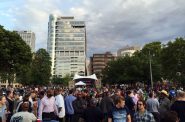 Sep 7th, 2021 by Carl Baehr
Sep 7th, 2021 by Carl Baehr
-
Gordon Place is Rich with Milwaukee History
 May 25th, 2021 by Carl Baehr
May 25th, 2021 by Carl Baehr
-
11 Short Streets With Curious Names
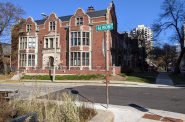 Nov 17th, 2020 by Carl Baehr
Nov 17th, 2020 by Carl Baehr






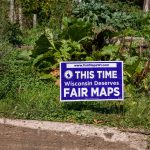








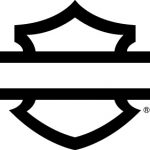





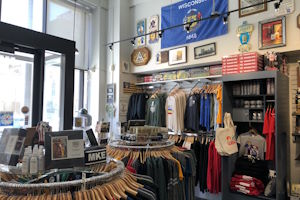
Wonderfully interesting! More of Mr Horne, please!
Michael Horne is always a welcome and fun read. Thanks for the new edition, Mr. Baehr, and to Mr. Horne for promoting it.
This made my day. Always a joy to read Michael
Horne’s columns. More please!
It is great to see an article by Michael Horne! He always wrote such interesting stories about the history of the people and places of our amazing city, Milwaukee. Seems like Urban Milwaukee no longer writes those interesting stories after Mr Horne retired.